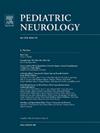Autoimmune Glial Fibrillary Acidic Protein Astrocytopathy Associated With Rhabdomyolysis: A Case Report
IF 3.2
3区 医学
Q2 CLINICAL NEUROLOGY
引用次数: 0
Abstract
Background
Glial fibrillary acid protein (GFAP) astrocytopathy is an autoimmune central nervous system disorder that rarely affects children. We describe a case of GFAP astrocytopathy with associated rhabdomyolysis in a pediatric patient.
Methods
We report a case report from a tertiary care university hospital.
Results
An 11-year-old girl developed subacute progressive neurological symptoms, beginning with vision changes and later followed by gait instability and lower extremity weakness over 2 months. On the day of presentation, she experienced new-onset upper extremity weakness. Examination revealed severe weakness of all 4 limbs and areflexia. She also had hematuria, with markedly elevated creatine kinase level of 64,408 U/L. Magnetic resonance imaging showed T2 hyperintensity in the optic chiasm and tract, a longitudinally extensive cord lesion, and cauda equina enhancement. Cerebrospinal fluid analysis revealed pleocytosis, elevated protein, and GFAP antibodies detected by cell-based assay. An electromyogram/nerve conduction study suggested peripheral nervous system involvement. Treatment with intravenous methylprednisolone, plasmapheresis, intravenous immunoglobulin, and rituximab led to partial clinical improvement.
Conclusion
This case highlights a rare presentation of GFAP astrocytopathy with subacute visual loss, severe weakness, areflexia, and rhabdomyolysis. Clinicians should consider GFAP astrocytopathy in pediatric patients presenting with combined central and peripheral nervous system involvement.
自身免疫性胶质纤维酸性蛋白星形细胞病伴横纹肌溶解1例报告
背景:胶质原纤维酸蛋白(GFAP)星形细胞病是一种很少影响儿童的自身免疫性中枢神经系统疾病。我们描述一个病例的GFAP星形细胞病与相关横纹肌溶解在儿科患者。方法报告一所大学三级医院的病例。结果一名11岁女孩出现亚急性进行性神经系统症状,开始视力改变,随后出现步态不稳定和下肢无力,持续2个月以上。在就诊当天,患者出现新发上肢无力。检查显示四肢严重无力和反射屈曲。患者同时有血尿,肌酸激酶水平明显升高64,408 U/L。磁共振成像显示视交叉和视束T2高信号,纵向广泛的脊髓病变,马尾增强。脑脊液分析显示细胞增多,蛋白升高,并通过细胞检测检测到GFAP抗体。肌电图/神经传导研究提示周围神经系统受累。静脉注射甲基强的松龙、血浆置换、静脉注射免疫球蛋白和利妥昔单抗治疗导致部分临床改善。结论本病例表现为罕见的GFAP星形细胞病,伴亚急性视力丧失、严重无力、反射屈曲和横纹肌溶解。临床医生应考虑GFAP星形细胞病在小儿患者表现为联合中枢和周围神经系统受累。
本文章由计算机程序翻译,如有差异,请以英文原文为准。
求助全文
约1分钟内获得全文
求助全文
来源期刊

Pediatric neurology
医学-临床神经学
CiteScore
4.80
自引率
2.60%
发文量
176
审稿时长
78 days
期刊介绍:
Pediatric Neurology publishes timely peer-reviewed clinical and research articles covering all aspects of the developing nervous system.
Pediatric Neurology features up-to-the-minute publication of the latest advances in the diagnosis, management, and treatment of pediatric neurologic disorders. The journal''s editor, E. Steve Roach, in conjunction with the team of Associate Editors, heads an internationally recognized editorial board, ensuring the most authoritative and extensive coverage of the field. Among the topics covered are: epilepsy, mitochondrial diseases, congenital malformations, chromosomopathies, peripheral neuropathies, perinatal and childhood stroke, cerebral palsy, as well as other diseases affecting the developing nervous system.
 求助内容:
求助内容: 应助结果提醒方式:
应助结果提醒方式:


